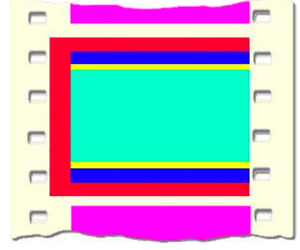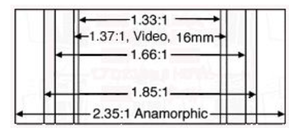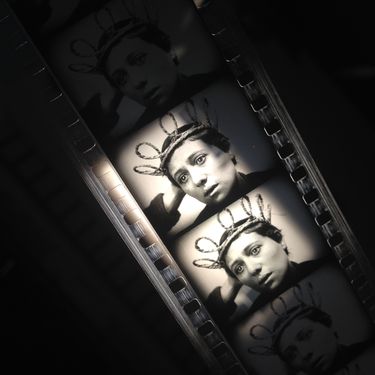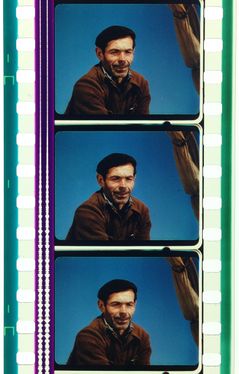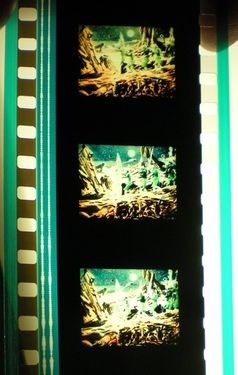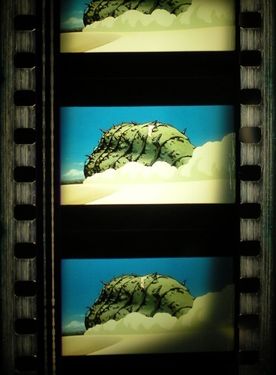| Welcome to Sprocket School! This project is maintained by volunteer editors. Learn more about how this works. |
Aspect ratios: Difference between revisions
JesseCrooks (talk | contribs) m (Removed capitalization on second S of Superscope.) |
JesseCrooks (talk | contribs) m (Added period.) |
||
| (2 intermediate revisions by the same user not shown) | |||
| Line 27: | Line 27: | ||
| 1.75:1 || || 1953 || || Early widescreen format used by MGM, Warner Brothers, and Disney. | | 1.75:1 || || 1953 || || Early widescreen format used by MGM, Warner Brothers, and Disney. | ||
|- | |- | ||
| 1.78:1 || || || || Used for films that originated on video. Equivalent to 16x9. | | 1.78:1 || || || || Used for films that originated on video. Equivalent to 16x9. Films printed in 1.78 may be scaled down to fit in the 1.85 image area with pillarboxing. | ||
|- | |- | ||
| 1.85:1 || Flat || 1953 || || Warning: widescreen formats may be soft-matted | | 1.85:1 || Flat || 1953 || || Warning: widescreen formats may be soft-matted. | ||
|- | |- | ||
| 2.00:1 || Superscope || c.1954 || || A short-lived anamorphic that employed the same 2:1 anamorphic squeeze as CinemaScope, but utilized a narrower portion of frame. | | 2.00:1 || Superscope || c.1954 || || A short-lived anamorphic that employed the same 2:1 anamorphic squeeze as CinemaScope, but utilized a narrower portion of frame. The image is centered on the full 1.33 frame, so it lacks the horizontal offset of other optical sound formats and the lateral alignment must be adjusted for projection. | ||
|- | |- | ||
| 2.39:1 || CinemaScope / Anamorphic || 1953 || || | | 2.39:1 || CinemaScope / Anamorphic || 1953 || || The aspect ratio for CinemaScope films with an optical soundtrack. Originally released in 2.35, the aspect ratio was later changed to 2.39:1, shortening the printed image area to better hide negative splices. | ||
|- | |||
| 2.55:1 || CinemaScope / Anamorphic || 1953 || || The original CinemaScope format, printed with 4-track magnetic sound. To accommodate the magnetic tracks, the perforations were narrowed. Prints in this format can only be run on projectors with CinemaScope (CS) sprockets, and should only be repaired with splicers that have smaller CS registration pins. The lateral alignment is slightly different that that of optical soundtrack formats. Some prints were released with an additional optical track that was half the width of a standard optical track. These are referred to as MagOptical prints. | |||
|- | |- | ||
|} | |} | ||
Latest revision as of 16:36, 12 May 2020
The aspect ratio is the ratio of the projected image's width:height when projected on the screen or printed on the film.
- define soft + hard matting, "native" aspect ratio, etc.
35mm
-
Aspect ratios as they appear in the film frame.
Red 1.33, Blue 1.37, Yellow 1.66, 'Green 1.85 -
Aspect ratios as they appear on a full-width screen.
| Aspect Ratio | Other names | Year of Introduction | Image | Notes |
|---|---|---|---|---|
| 1.33:1 | Silent / Full Frame | 1907 | ||
| 1.19:1 | Movietone | 1926 | Often projected with 1.37 lenses and aperture plates in theaters without properly sized 1.19 lenses and plates; however, doing this will chop off a substantial portion of the height of the image. In auditoriums with fixed-height screens, 1.19 can be adequately presented by removing the anamorphic attachment from the spherical lens used for 2.39 and using that in conjunction with the 2.39 aperture plate. | |
| 1.37:1 | Academy ratio | 1932 | Sometimes incorrectly called 1.33. Was used well past 1953 in some countries outside of the US. See also: List of 35mm features released in 1.37 after 1953. | |
| Windowboxed 1.37:1 | ? | Projected with a 1.85 lens and aperture plate, these prints are often rereleases of films made in traditional 1.37 that will be shown in wide release at theaters not outfitted with 1.37 lenses. | ||
| 1.66:1 | 1953 | Commonly used in Europe to provide additional height for subtitles. Warning: widescreen formats may be soft-matted. | ||
| 1.75:1 | 1953 | Early widescreen format used by MGM, Warner Brothers, and Disney. | ||
| 1.78:1 | Used for films that originated on video. Equivalent to 16x9. Films printed in 1.78 may be scaled down to fit in the 1.85 image area with pillarboxing. | |||
| 1.85:1 | Flat | 1953 | Warning: widescreen formats may be soft-matted. | |
| 2.00:1 | Superscope | c.1954 | A short-lived anamorphic that employed the same 2:1 anamorphic squeeze as CinemaScope, but utilized a narrower portion of frame. The image is centered on the full 1.33 frame, so it lacks the horizontal offset of other optical sound formats and the lateral alignment must be adjusted for projection. | |
| 2.39:1 | CinemaScope / Anamorphic | 1953 | The aspect ratio for CinemaScope films with an optical soundtrack. Originally released in 2.35, the aspect ratio was later changed to 2.39:1, shortening the printed image area to better hide negative splices. | |
| 2.55:1 | CinemaScope / Anamorphic | 1953 | The original CinemaScope format, printed with 4-track magnetic sound. To accommodate the magnetic tracks, the perforations were narrowed. Prints in this format can only be run on projectors with CinemaScope (CS) sprockets, and should only be repaired with splicers that have smaller CS registration pins. The lateral alignment is slightly different that that of optical soundtrack formats. Some prints were released with an additional optical track that was half the width of a standard optical track. These are referred to as MagOptical prints. |
35mm aspect ratio gallery
(click to enlarge)
-
1.33 Full Frame silent print of The Passion of Joan of Arc (1928)
-
1.37 with mono optical track, Pandora and the Flying Dutchman (1951)
-
Windowboxed 1.37:1
-
Hard-matted 1.85:1
Determining 35mm aspect ratios for projection
For some film gauges, the aspect ratio will be obvious. 16mm is rarely anything but full frame (though there are variations - see 16mm page). Other small gauges are rarely anything but their native aspect ratios. 35mm, however, can be complicated. Determining aspect ratio is one of the reasons that prints should be inspected before being run. See Inspection for more details on the process.
- The first way to determine the aspect ratio is to find out when the film was made and using your knowledge of film history, assign its aspect ratio.
- The second and complementary way is to look at a frame of the print and using the different aperture plates, try to eyeball which looks best. You can do this first with at the light table, and then if possible by viewing some of the film on screen.
- It's often best to look at the framing of the opening credits, or at a scene with subtitles.
Be aware that there are always exceptions to any these rules. And: don't just trust IMDb!
- Determining correct aspect ratios for widescreen, etc.
- Do not always trust what's written on the can or on the print! If you receive a print that is incorrectly labeled by another venue or projectionists (and you are certain of it) make sure to correct it or remove the label. If the label is from the distributor or archive, don't remove it but make a note that the information is incorrect.
- Eyeballing and measuring
- Educated guesses based on year, studio, country, etc. See Inspection page for information on determining the year a print was struck.
- Caveat: there is no "correct," historically - so contentious!
- For films that have been released on DVD or Blu-Ray there is often a lot of information online about the "original" aspect ratio of the film. Sites like IMDB and TCM can be helpful, but always use this information along with one of the above techniques as they are not always correct!
Small Gauges: 8mm, Super 8, etc.
- Super 8 - 1.36:1
- 9.5mm - 1.31:1
- 28mm - 1.36:1
Related Pages
- 16mm See: 16mm aspect ratios
- 70mm See: 70mm aspect ratios
- Aperture plate
- Lens
- Masking
External Links
- Essay: Invasion of the Aspect Ratios
- Advice from Jean-Pierre Léaud: YouTube
